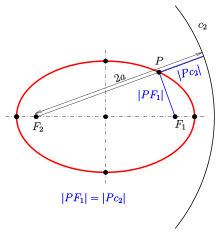Ellipse
Ellipse
As such, it is a generalization of a circle, which is a special type of an ellipse having both focal points at the same location. The shape of an ellipse (how "elongated" it is) is represented by its eccentricity, which for an ellipse can be any number from 0 (the limiting case of a circle) to arbitrarily close to but less than 1.
Ellipses are the closed type of conic section: a plane curve resulting from the intersection of a cone by a plane (see figure below). Ellipses have many similarities with the other two forms of conic sections: parabolas and hyperbolas, both of which are open and unbounded. The cross section of a cylinder is an ellipse, unless the section is parallel to the axis of the cylinder.
An ellipse (red) obtained as the intersection of a cone with an inclined plane
Analytically, an ellipse may also be defined as the set of points such that the ratio of the distance of each point on the curve from a given point (called a focus or focal point) to the distance from that same point on the curve to a given line (called the directrix) is a constant. This ratio is the above-mentioned eccentricity of the ellipse.
An ellipse may also be defined analytically as the set of points for each of which the sum of its distances to two foci is a fixed number.
Ellipses are common in physics, astronomy and engineering. For example, the orbit of each planet in our solar system is approximately an ellipse with the barycenter of the planet–Sun pair at one of the focal points. The same is true for moons orbiting planets and all other systems having two astronomical bodies. The shapes of planets and stars are often well described by ellipsoids. Ellipses also arise as images of a circle under parallel projection and the bounded cases of perspective projection, which are simply intersections of the projective cone with the plane of projection. It is also the simplest Lissajous figure formed when the horizontal and vertical motions are sinusoids with the same frequency. A similar effect leads to elliptical polarization of light in optics.
Video: Equation of an Ellipse, Deriving the formula
Definition of an ellipse as locus of points

Ellipse: Definition

Ellipse: definition with director circle
An ellipse can be defined geometrically as a set of points (locus of points) in the Euclidean plane:
-
An ellipse can be defined using two fixed points, , , called the foci and a distance, usually denoted . The ellipse defined with , and is the set of points such that the sum of the distances is constant and equal to . In order to omit the special case of a line segment, one assumeshttps://wikimedia.org/api/rest_v1/media/math/render/svg/8f096d24464c8357..."> More formally, for a given , an ellipse is the set
The midpoint of the line segment joining the foci is called the .....
‹ Cylinder video up Ellipse video ›


 ,
,  , called the foci and a distance, usually denoted
, called the foci and a distance, usually denoted  . The ellipse defined with
. The ellipse defined with  such that the sum of the distances
such that the sum of the distances  is constant and equal to
is constant and equal to  , an ellipse is the set
, an ellipse is the set 
 of the line segment joining the foci is called the .....
of the line segment joining the foci is called the .....
